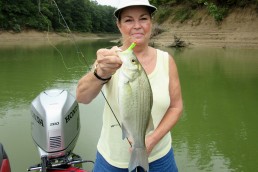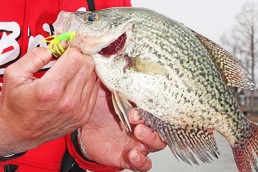High-water River Success
SHARE THIS POST
Until recently, high water on our rivers has been only a memory. But with recent rains combined with runoff from up north, river levels have stayed high in many locations. Midwest rivers, like the Mississippi, Wisconsin, Illinois and Rock, have all experienced higher water levels, albeit different degrees. When this occurs, it’s a whole new ballgame regarding river fishing.
But it’s not as bad as one might think. You can still go out and reap the rewards of good catches if you know where to look.
By making a few simple adjustments to your approach, you will be able to locate and catch some nice fish while other anglers may stay at home due to the high waters. Over my years on fishing rivers, I have found that high and rising water conditions seem to really stump a large number of anglers from catching fish consistently. The fact remains that the fish are still in the rivers. They have not left, but to be successful in catching them you must make some changes to your game plan.
When high water occurs, you will want to make a move into the many flooded sloughs and backwater areas all along the river and enjoy the quality fishing available.
With the higher water conditions now, you will find that when you enter these backwater areas there is more brush, trees and grass than you would normally expect to see. Because of this, there is obviously much more cover for the fish to hide in and use as ambush points for unsuspecting prey. The problem is many anglers get confused where to start their search when confronted with all this flooded brush and timber.
Well, it’s really pretty simple my friends.
Break the area down into sections. As a good rule of thumb, cover 300-foot sections at a time. Now, 300 feet might not sound like much, but you will find that to really work it properly over every nook and cranny, it will take much longer than you think. Keep in mind that being thorough is key. In high-water conditions, the fish have a lot more area to use as cover, so you will have to really work these areas over well.
One thing that I do want to mention is that when you pick out a backwater area or slough, try and find ones that have a limited current flow. Areas of running current will not hold as many fish as those areas that are away from fast current. Light current is good for some species, but again, fast-current areas can be difficult to fish correctly. Remember, the fish are in these areas to get away from the faster currents of the main river areas.
High-water season can bring on some truly great fishing, especially for folks who like to fish for bluegills. When in the backwaters and sloughs, you will want to search out areas of new emerging grass that have been flooded over, as well as flooded areas of brush. The bluegills will relate to these areas and feed on the insect larvae and small bugs. You can find them in shallow water, at 1 foot, or as deep as 10 feet. This will largely depend on weather conditions. Cold fronts will keep them deep, and warmer weather will find them shallow.
Are you enjoying this post?
You can be among the first to get the latest info on where to go, what to use and how to use it!
As far as baits, stick with small ice jig-type lures tipped with spikes or waxworms. Fish this presentation suspending them under a small float, and you’re in business. When you find one bluegill, there will likely be more.
Another favorite is the crappies. Look for them using areas of flooded timber and deadfalls in the water. Deadfalls located near, but not necessarily in deep water, tend to hold bigger fish now. This is also a situation where weather—cold fronts—will dictate if the crappies are deep or shallow.
For presentation, it’s tough to beat small a small crappie minnow fished on a small hook suspended under a tiny slip bobber rig. This is a very deadly setup for crappies. Another method for crappies in flooded timber is using a long, 10- to 14-foot pole and slowing lowering your presentation vertically right down into the flooded brush. You can make very pinpoint presentations with this setup. When a fish hits, simply lift it straight up out of the cover to avoid getting snagged.
For bass anglers, higher water conditions in spring can bring some fabulous fishing. The one thing you will have to do though is really concentrate your efforts on the heavy flooded brush and timber. Don’t be afraid to get into the thickest cover you can find, as long as it has deep water for the bass. Many times you’ll have to get way back into the cover to find the fish, but the extra effort will be well worth it when you catch that big bass.
As far as presentation, you will be limited in what you can use. Rigs such as jig-n-pigs work well, as you can either pitch or flip them. Personally, I enjoy the flipping method due to the fact that I am fishing really dense cover and can be much more accurate with the lure. Accuracy in your presentation will account for more bass in the boat.
Catfish are one of my favorites in the backwaters and sloughs during higher water. Again, look for large deadfall and snag areas in the water. Catfish have a tendency to use these areas and can be caught consistently. When fishing for Mr. Whiskers, you will find that most of your standard catfish rigs work very well. One thing I do recommend is that since the water is still cool, use some type of cut bait fished close to the bottom. You will also want your bait on the upstream side of the cover so the scent from the bait will draw the catfish to it.
Two other overlooked species many anglers are not even aware of in the backwaters and slough areas are walleyes and saugers. Both of these can be found in good quantities during high-water conditions. Look for areas of flooded willows and timber. One of the best presentations to use is to pitch small, weedless jigs tipped with a minnow in the cover and work it back through. You will be surprised at how many walleyes and saugers can be caught using this method.
So, the next time you feel like getting out to do some spring fishing, don’t let the high water change your plans and get into those backwater areas.
Email your outdoors questions to Mike Cyze at: lastcast13@yahoo.com. You can also check out his blog at: lastcastoutdoors.com or listen to him on ESPN Radio.
MWO
SHARE THIS POST
Did you enjoy this post?
You can be among the first to get the latest info on where to go, what to use and how to use it!
Mike Cyze
Mike Cyze has been called one of the most knowledgeable multispecies river anglers in the country. His ability to catch fish under the challenging conditions encountered in the river environment, combined with his overall fishing knowledge, has earned him recognition as a true Mississippi River Expert. Contact him at: lastcast13@yahoo.com.



